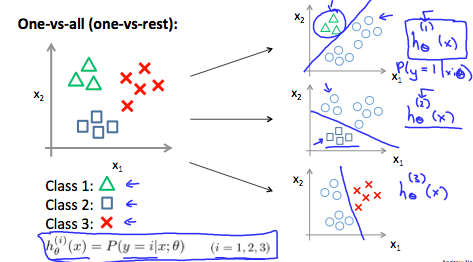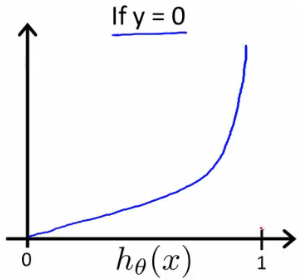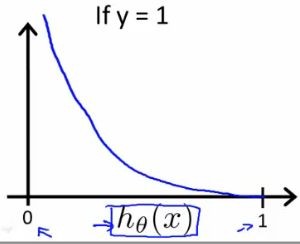Classification Problem
Binary Classification Problem
y is either 0 or 1.
Multiclass Classification Problem
y is from 0 to n.
- Train a logistic regression classifier $$h_\theta(x)$$ for each class to predict the probability that $$y = i$$
To make a prediction on a new $$x$$, pick the class that maximizes $$h_\theta(x)$$
Choose 1 class, lump all the others into a single second class
- Do this repeatedly, applying binary logistic regression to each case
- Use the hypothesis that returned the highest value as our prediction
$$ y \in {0...n}\ h\theta^{(i)}(x) = P(y = i|x; \theta)\ prediction = \max_i(h\theta^{(i)}(x))
$$

Logistic Regression
- Problem with linear regression
- Doesn't make sense for $$h_\theta(x)$$ to be
> 1or< 0
- Doesn't make sense for $$h_\theta(x)$$ to be
Solution
Logistic/sigmoid function: fit $$h_\theta(x)$$ in between
0&1$$ h\theta(x) = g(\theta_Tx) = g(z) = \frac{1}{1+e^{-z}}\ h\theta(x) = P(y=1|x;\theta) = 1 - P(y=0|x;\theta) $$

Gives probability that the output is
1
Decision Boundary
The line separating the area where y = 0 and y = 1. It is created by our hypothesis function.
$$ z \ge 0 \rightarrow h\theta(x) \ge 0.5 \rightarrow 1\ z \lt 0 \rightarrow h\theta(x) \lt 0.5 \rightarrow 0
$$
Cost Function
Original cost function for linear regression (i.e. squared-error) cannot be applied, since it does not produce a convex function with no local minima.
Negative Logarithmic Function
Always convex.
$$ \begin{align}
J(\theta) &= \frac{1}{m}\sum^m{i=1}Cost(h\theta(x^{(i)}), y^{(i)})\ Cost(h\theta(x), y) &= -log(h\theta(x)) &\text{ if } y = 1\ &= -log(1 - h_\theta(x)) &\text{ if } y = 0
\end{align}
$$


$$ \begin{align}
Cost(h\theta(x), y) &= 1 &\text{ if } h\theta(x) = y\ &\rightarrow \inf &\text{ if } h_\theta(x) \rightarrow (1-y) \text{ where } y = 0, 1
\end{align}
$$
Simplified
$$ Cost(h\theta(x), y) = -y log(h\theta(x)) - (1-y)log(1-h\theta(x))\ J(\theta) = \frac{1}{m}\sum^m{i=1}[-y^{(i)} log(h\theta(x^{(i)})) - (1-y^{(i)})log(1-h\theta(x^{(i)}))]
$$
Vectorized
$$ h = g(X\theta)\ J(\theta) = \frac{1}{m}[-y^T log(h) - (1-y)^Tlog(1-h)]
$$
Gradient Descent
Same algorithm as in linear regression.
$$ \begin{align}
&\text{Repeat: {}\ &\hspace{1cm}\thetaj := \theta_j - \alpha\frac{1}{m} \sum^{m}{i=1}{((h_\theta(x^{(i)}) - y^{(i)})x_j^{(i)})}\ &\text{}}
\end{align}
$$
Vectorized
$$ \begin{align}
&\text{Repeat: {}\ &\hspace{1cm}\theta_j := \theta_j - \alpha\frac{1}{m} X^T(g(X\theta)-\vec{y})\ &}
\end{align}
$$
Advanced Optimization
- Conjugate gradient
- BFGS
- L-BFGS
Implementation
- Provide $$J(\theta)$$ & $$\frac{\partial}{\partial \theta_j}J(\theta)$$
function [jVal, gradient] = costFunction(theta) jVal = [...code to compute J(theta)...]; gradient = [...code to compute derivative of J(theta)...]; end - Use the provided optimization algorithm
fminuncwith option creating functionoptimsetoptions = optimset('GradObj', 'on', 'MaxIter', 100); initialTheta = zeros(2,1); [optTheta, functionVal, exitFlag] = fminunc(@costFunction, initialTheta, options);